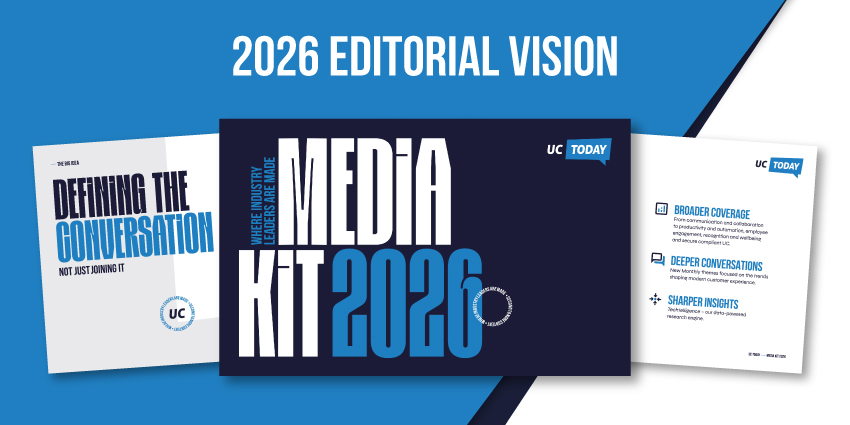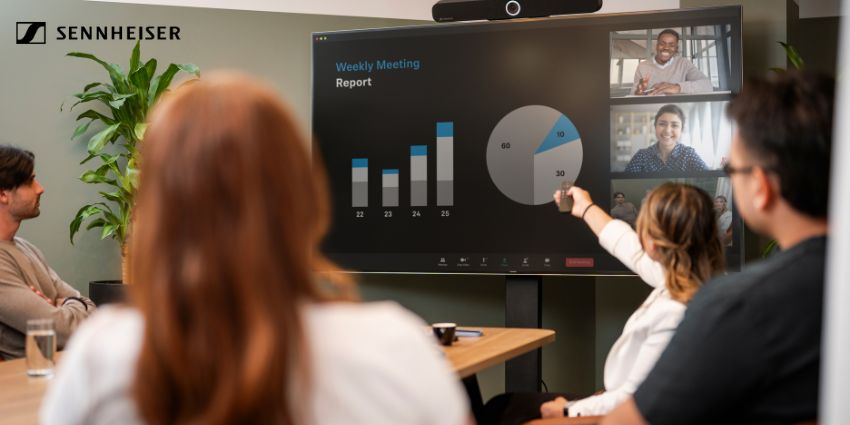Is the right workplace management software the key to successful collaboration?
Hybrid work isn’t going away. You can tell because most offices still look half-empty certain days. Entire floors sit unused while people swap between home and the office. It’s expensive, messy, and exactly why more companies are investing in workplace management software.
Take a walk through a corporate headquarters. You’ll probably see screens showing booked meeting rooms that nobody’s actually using. Facilities teams are trying to figure out what gets cleaned, what stays dark, and how to measure any of it with real numbers. 87% of large companies have completely changed their office layout. No wonder leaders are frustrated.
Workplace management software and meeting room management tools are how companies improve employee productivity, streamline collaboration, and enhance engagement.
What Is Workplace Management Software?
Workplace management software, sometimes called “meeting room management software” or “integrated workforce management software” is more than just a booking system.
It’s a powerful technology solution designed to help business leaders optimize their workspaces. It tracks which spaces get used, by whom, and how often. It handles reservations. It shows you patterns. Some systems even predict what you’ll need next quarter.
The label “integrated workplace management software” covers tools that go beyond scheduling. They might handle lease contracts. Utilities. Maintenance tickets. It’s all in the same environment so there’s less guesswork. IBM says this tech can improve decision making, and improve facility usage efficiency by 39.3%.
A few examples of what these platforms do:
- Meeting room management systems connect with Microsoft Teams, Outlook or Google so people don’t double-book (or wander around looking lost).
- Desk reservations sync with hybrid schedules. You see who’s in and plan around it.
- Floor plans update live so facilities teams can track usage.
- Dashboards lay out costs, occupancy, energy: the things your CFO asks about.
Some vendors lean more on user experience. Robin and Joan are worth looking at if that’s your priority. Others, MRI and Nuvolo for example, go deep into compliance and facilities workflows.
AI is slipping into the conversation too. Asana now offers Smart Weighted Goals that connect project plans to real-world space needs. Some platforms like Microsoft places can suggest booking options based on employee workflows.
The Features of Workplace Management Software
If you’re weighing whether workplace management software is worth the budget, this is usually the part that tips the scales. The real value shows up when you see how these systems pull everything into one place.
Different platforms handle this differently. Some specialize in user-friendly booking tools. Others layer in complex analytics. The good ones do both without making you feel like you need a certification just to log in.
Here are the big capabilities most enterprise teams look for:
1. Meeting Room Management Systems
It’s the most obvious use case. You’ve got dozens (or hundreds) of conference rooms. People need to reserve them without double bookings, ghost meetings, or confusion about tech setups.
A good meeting room management system plugs into your calendars, whether that’s Outlook, Google Workspace, or something else, and your UC tools like Teams or Zoom. You can see availability in real time. Reserve a spot. Get reminders. In some setups, the system even checks if no one shows up and frees the room automatically.
2. Desk Booking and Hybrid Schedules
This feature exploded when hybrid work took off. Employees want to know where they’re sitting before they bother commuting. Facilities teams need to track usage so cleaning and security can adjust. Hybrid workplace management software often includes an app or portal for reservations. People pick their desk. With tools like Microsoft Places, they even see who they’ll be sitting next to.
Plus, companies can create policies that actively nudge employees to book physical meeting or desk spaces for a certain amount of time each week.
3. Interactive Floor Plans and Visitor Management
You can’t manage what you can’t see. Interactive maps let teams see where resources are, track occupancy, and plan moves. It sounds simple, but a lot of companies still rely on static PDFs. Real-time visuals make a big difference when you’re juggling hundreds of desks and rooms.
These features also support visitor management. Maps guide guests to where they need to be, while other features handle check-ins, badge printing, and host notifications. Some platforms integrate visitor workflows into the same app employees use for reservations, which keeps things simpler.
4. Analytics and Reporting
This is where leadership usually pays attention. Dashboards track metrics like occupancy rates, energy usage, and cost per square foot. If your CFO or COO wants to know whether all that real estate is earning its keep, you’ll have the numbers ready.
Insights can help business leaders find underutilized rooms and spaces. Some software, connected with IoT devices, can also draw information from sensors, to detect the quality of meeting spaces, and how they impact employee wellbeing.
5. Full-Stack Observability and Multi-Vendor Environments
Some IT teams want to track not just occupancy but also the performance of the apps and devices in those rooms. Voss’s solutions are interesting here. They show how space and workplace management software can connect to UC service management tools so you get a single view of usage and performance. Their “single pane of glass” approach means fewer surprises when something fails mid-meeting.
Speaking of integrations, many solutions integrate with other tools, such as visitor and guest management systems and building access control technology.
Workplace Management Software: Business Benefits
Let’s be honest, nobody buys new tech because it sounds good. Sooner or later, someone’s going to ask about ROI. These systems aren’t free, and adoption takes work.
So, what does success actually look like? Here are a few outcomes you can expect if you pick the right platform and get buy-in across teams.
Less Wasted Space
You can’t cut real estate costs if you don’t know what’s sitting empty. Some case studies show companies using space management software to reduce their real estate footprint by 30% or more. Investing in this tech doesn’t have to mean downsizing immediately, but it does ensure you have the data you need to decide if you should.
Plus, with insights into room utilization, business leaders can make more intelligent decisions about workplace scheduling and future investments.
Better Employee Experience
It’s one thing to talk about hybrid flexibility. It’s another to actually deliver it. One study found that 40% of in-office employees waste as much as 30 minutes each day just looking for a suitable meeting space. Meeting room management technology ensures employees can access streamlined and intuitive booking tools that allow them to schedule meetings instantly.
The moment employees can see available desks, book a space in seconds, and get automatic confirmations, the office starts feeling like a more attractive place.
More Reliable Data for Leadership
When finance or HR asks for occupancy trends or usage costs, you don’t want to fumble around for half-baked reports. Integrated workplace management software gives you real-time dashboards you can pull up in a meeting instantly.
These tools can also help business leaders understand how employees use their meeting rooms and uncover ways of making spaces more productive and efficient. Some solutions even include access to intelligent monitoring tools that can help companies improve the health and safety of their meeting spaces. They can track environmental conditions like occupancy levels and temperature.
Improved Sustainability Metrics and compliance
Energy usage and emissions are becoming board-level issues. If you can prove you’re cutting consumption by consolidating space or automating lighting and HVAC, you’re helping sustainability teams hit their goals. Some companies even use occupancy data to claim green building credits.
Plus, you reduce risks on a broader scale. A solid meeting room management system tracks who’s in the building and when. If you need audit trails for security or health regulations, this is extremely valuable.
Industry Use Cases and Success Stories
Different sectors have their own pain points. One reason hybrid workplace management software is spreading fast is that it adapts to all kinds of operational realities. Here are a few examples that come up often in enterprise buying conversations:
- Financial Services: Big banks have sprawling offices and tight compliance rules. They need precise records of who booked which spaces and when. Visitor logs aren’t optional. Also, the stakes are high, because clients expect professional, predictable meeting experiences. If a room’s AV setup fails during a critical deal negotiation, it’s not just an inconvenience.
- Technology and Professional Services: These companies care about two things: talent and agility. Engineers and consultants want flexible options. Leadership wants proof that expensive leases are actually used. Companies are now combining occupancy analytics with real estate forecasting to decide whether to expand or consolidate.
- Healthcare: Hospitals and clinics don’t operate like corporate offices. But the principles are similar: manage space, track usage, and control costs. The twist is stricter compliance, especially around who enters certain areas. Visitor management tools with automatic badge printing are common in this sector.
- Higher Education: Universities were early adopters of space and workplace management software, partly because campus scheduling has always been a puzzle. Meeting room systems help coordinate everything from student study spaces to administrative offices.
- Manufacturing: Hybrid work isn’t as prevalent on factory floors, but support functions, finance, HR, and engineering often have hybrid teams. These groups still need desk booking and meeting room management systems.
Getting Started with Workplace Management Software
Buying workplace management software is only half the challenge. Rolling it out without causing chaos is the part most teams underestimate. Here are a few lessons from companies that have done this before.
- Start With One Clear Owner: If IT owns integrations, HR owns policy, and Facilities owns adoption, pick one person to coordinate. Otherwise, decisions don’t get made. That person doesn’t need to have all the answers, but they should be accountable for moving the project forward.
- Run a Pilot First: It’s tempting to go big right away. But piloting in one region or floor gives you room to catch surprises. Maybe the booking flow feels clunky. Maybe signage doesn’t sync. Better to find out early.
- Train Before You Launch; Don’t assume employees will figure it out just because the interface looks “simple.” Show them how to reserve desks, cancel bookings, and check room availability. Some companies even run short drop-in sessions or create short videos.
- Think About Change Management: The real friction often comes from habits, not tech. People are used to sitting wherever, or defaulting to email threads to book meetings. A new system requires nudging. Consistent reminders. Incentives sometimes. Be ready for some resistance.
- Review and Tweak: Don’t wait six months to see if adoption is working. Check weekly. Which features get used? Where are people dropping off? Many platforms include analytics that help you track this in real time.
If you’re deep in planning for collaborative workspaces, check out these resources:
How to Choose the Right Workplace Management Solution
Let’s be real. There are dozens of vendors, and most of them look similar on the surface. Picking the right workplace management software is easier if you start by being honest about your priorities.
What Problem Are You Solving First?
It helps to pick a clear starting point. Maybe you need better data for finance. Maybe your goal is improving the employee experience. Maybe compliance is driving the project. Trying to tick every box from day one usually ends in frustration.
Who Needs to Use It?
Some systems are great for employees: simple apps, fast booking. Others cater to facilities teams or real estate strategists. You’ll want to demo workflows for each audience. A great CFO dashboard isn’t much help if employees hate booking desks.
Which Integrations Matter?
This question often causes confusion. You’ll need to connect calendars (Google Workspace, Outlook), maybe identity systems (Azure AD, Okta), and possibly sensors or IoT devices. It’s worth asking vendors exactly what integrations are prebuilt vs. custom.
What’s the Implementation Timeline?
Ambitious rollouts often take longer than expected. Talk to reference customers. Learn what tripped them up. If your internal teams are stretched thin, look for vendors with solid onboarding support or partners who can help with integration.
Can You See a Roadmap?
This software evolves fast. Ask vendors to show you what’s on the horizon. AI, sustainability dashboards, better reporting – all of these future releases might be part of your business case. Talk to peers. Find out which platforms actually delivered on promises. A polished demo is helpful, but firsthand stories from other companies are usually more revealing.
The Future of Workplace Management Software
This workplace keeps changing. If you haven’t looked closely in a year or two, you’ll notice a few trends starting to reshape what workplace management software can do.
- Predictive Occupancy: A lot of companies are tired of static reports. They want forecasts. Modern platforms use historical patterns, badge data, and even weather to guess how full spaces will be. If Fridays are always quiet, the system can recommend consolidating staff on fewer floors. Less energy. Less cleaning. Fewer complaints.
- AI-Powered Recommendations: Some tools don’t just show data. They nudge you toward decisions. For example, if a floor has been under 20% occupancy for three months, you might get a prompt to repurpose or sublease. Asana is weaving this logic into its Smart Weighted Goals, connecting workspace performance to team targets.
- Sustainability Dashboards: Boards and investors are demanding proof that buildings are running efficiently. That means clear data on energy, water, and emissions. Some systems can now model the impact of schedule changes on carbon output.
- Unified Endpoint Management: Hybrid work adds complexity. Laptops, video bars, sensors, everything needs to stay patched and secure. Unified Endpoint Management as the connective tissue between workplace systems and IT controls.
- Full-Stack Observability: This sounds technical because it is. If you rely on multiple vendors, such as Teams, Zoom, Jabra, and Cisco, you don’t want a blame game when something fails. UCSM software combined with workforce management tools can boost visibility.
Managing the Modern Workplace
Workplace management software isn’t just another IT tool. It sits at the intersection of real estate, HR, facilities, and employee experience. That’s why it can feel complicated. But the goal is pretty simple: give people what they need to work well, and make sure the spaces you’re paying for aren’t wasted.
Every business is constantly searching for ways to improve employee productivity, streamline collaboration, and enhance engagement. That hasn’t changed. What’s different now is that leadership expects proof: data that shows what’s working and what needs a rethink.
Start by clarifying what success means for your organization. Is it cutting real estate costs by 15%? Increasing meeting room utilization? Making hybrid work feel more predictable? Those answers will help you sort vendors faster than any spec sheet.
If you’re ready to dive deeper into workplace upgrade strategies, we’re here to help.
- Learn all about the future of work, and the trends coming to meeting rooms and hybrid offices with our UC market reports
- Chat about meeting spaces, immersive tech, full-stack observability and AI, with experts in the UC Community
- Visit upcoming events for an opportunity to test the best workplace management tools and systems for yourself.
Alternatively, check out our ultimate UC Buyer’s guide, for help planning your path forward.







